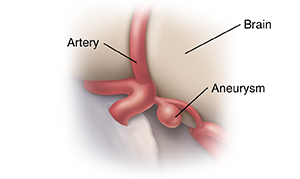What Is a Brain Aneurysm?
A brain aneurysm is a bulge in the wall of a brain artery. Arteries are the blood vessels that carry blood to organs, such as the brain. A brain aneurysm can occur in an artery wall that is weak or has a defect. Brain aneurysms can occur at any age, but they are more common in adults than in children. They are also more common in women than in men.
Aneurysm is often linked with hardening of the arteries. Other risk factors include:
If the bulge in a brain artery tears and bleeds, nearby brain tissue may be damaged. This can cause severe problems or death.

Symptoms
In most cases, a brain aneurysm has no symptoms until it bleeds or tears. Symptoms of this can include:
-
Severe headache, usually of very sudden onset
-
Nausea and vomiting
-
Stiff neck
-
Brief blackout
-
Confusion
-
Slow movements
-
Clumsiness
-
Vision or speech problems
-
Paralysis or weakness on one side of the body
-
Jerking movements, such as seizures or convulsions
-
Coma
Getting medical care fast
A healthcare provider needs to assess and treat a brain aneurysm right away, if possible. This may save the person's life. The healthcare team will call specialists once they know the cause. Treatment will start right away if the aneurysm has bled.
In some cases, only supportive medical care may be used to treat bleeding. If the aneurysm has bled, treatment may not reverse damage to the brain. But surgery may help. It can prevent more bleeding. It can remove trapped blood in and around the brain. And it can relieve extra pressure on the brain. Or, your provider may do other forms of therapy. These include endovascular coiling or microvascular clipping. These can prevent more bleeding.
In some cases, an aneurysm can lead to severe brain injury. This may require medical life support. Sometimes even the most intensive treatment can’t save the person’s life.
Working with the healthcare team
Your loved one may be too ill to know what’s going on. You may need to decide on the extent of their treatment. The healthcare team will answer any questions you have. Choose only a few family members to talk to the healthcare team. These family members can share what they learn with others. Doing this will make it simpler to keep everyone informed. If the situation is critical and your loved one has a living will, or has designated someone with a medical power of attorney, be sure to let the health team know and provide copies of the documents.